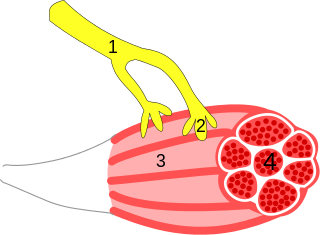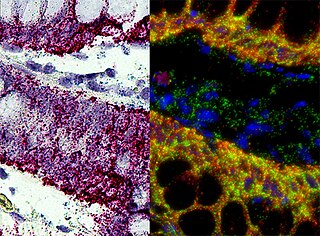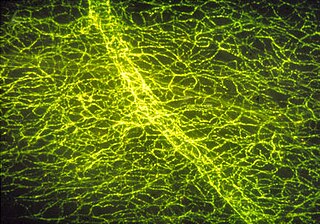The Falck-Hillarp method of fluorescence (the F-H method) is a technique that makes it possible to demonstrate and study, with unique precision and susceptibility, certain monoamines, among those the three catecholamines dopamine, noradrenaline, and adrenaline, as well as serotonin and related substances. [1] [2]

A catecholamine is a monoamine neurotransmitter, an organic compound that has a catechol and a side-chain amine.

Dopamine is an organic chemical of the catecholamine and phenethylamine families. It functions both as a hormone and a neurotransmitter, and plays several important roles in the brain and body. It is an amine synthesized by removing a carboxyl group from a molecule of its precursor chemical L-DOPA, which is synthesized in the brain and kidneys. Dopamine is also synthesized in plants and most animals. In the brain, dopamine functions as a neurotransmitter—a chemical released by neurons to send signals to other nerve cells. The brain includes several distinct dopamine pathways, one of which plays a major role in the motivational component of reward-motivated behavior. The anticipation of most types of rewards increases the level of dopamine in the brain, and many addictive drugs increase dopamine release or block its reuptake into neurons following release. Other brain dopamine pathways are involved in motor control and in controlling the release of various hormones. These pathways and cell groups form a dopamine system which is neuromodulatory.

Adrenaline, also known as epinephrine, is a hormone, neurotransmitter, and medication. Adrenaline is normally produced by both the adrenal glands and certain neurons. It plays an important role in the fight-or-flight response by increasing blood flow to muscles, output of the heart, pupil dilation response, and blood sugar level. It does this by binding to alpha and beta receptors. It is found in many animals and some single cell organisms. Napoleon Cybulski first isolated adrenaline in 1895.
The method is based on the important and decisive discovery that these compounds are able to react with formaldehyde – in near complete absence of water – to form fluorophores, i.e. molecules that, when irradiated with light invisible to the eye, will emit visible light. This happens in a “dry” state, without extracting the monoamines from the cells during the entire procedure, a process that starts with separation of a tissue sample and ends with a thin tissue slice that can be examined in a fluorescence microscope.

Formaldehyde (systematic name methanal) is a naturally occurring organic compound with the formula CH2O (H−CHO). It is the simplest of the aldehydes (R−CHO). The common name of this substance comes from its similarity and relation to formic acid.

A fluorophore is a fluorescent chemical compound that can re-emit light upon light excitation. Fluorophores typically contain several combined aromatic groups, or planar or cyclic molecules with several π bonds.
The F-H method allowed, for the first time, the examiner to watch these monoamines light up in the microscope and to precisely determine in which cells they were present, and thereby understanding their functions. [3] The method was developed by Bengt Falck and Nils-Åke Hillarp in the 1960s at the Department of Histology, University of Lund. For intense neurobiological research it became possible to demonstrate the presence of monoamines in nerve cells belonging to the central and the peripheral nervous system and for the first time comprehend that these substances act as signal substances, i.e. transmitters.
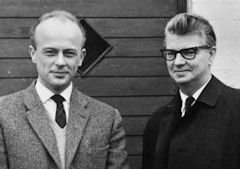
Bengt Olof Torsten Falck is a Swedish scientist, who is professor emeritus at the Faculty of Medicine at Lund University, Sweden. Falck has published numerous works in the fields of histology, endocrinology and neurobiology.
Nils-Åke Hillarp was a Swedish scientist and a prominent force in research on the brain's monoamines.

The central nervous system (CNS) is the part of the nervous system consisting of the brain and spinal cord. The CNS is so named because it integrates the received information and coordinates and influences the activity of all parts of the bodies of bilaterally symmetric animals—that is, all multicellular animals except sponges and radially symmetric animals such as jellyfish—and it contains the majority of the nervous system. Many consider the retina and the optic nerve, as well as the olfactory nerves and olfactory epithelium as parts of the CNS, synapsing directly on brain tissue without intermediate ganglia. As such, the olfactory epithelium is the only central nervous tissue in direct contact with the environment, which opens up for therapeutic treatments. The CNS is contained within the dorsal body cavity, with the brain housed in the cranial cavity and the spinal cord in the spinal canal. In vertebrates, the brain is protected by the skull, while the spinal cord is protected by the vertebrae. The brain and spinal cord are both enclosed in the meninges. Within the CNS, the interneuronal space is filled with a large amount of supporting non-nervous cells called neuroglial cells.
The initial publication, written already in 1961, [4] described a wide-ranging examination of nerves supplying a large number of organs in the body. This work validated the concept of Ulf von Euler, the Nobel prize winner, that noradrenaline is the signal substance in peripheral autonomic nerves. In the same year, this first publication was followed by an explanation of the chemical background of the F–H method.
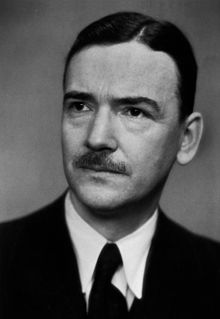
Ulf Svante von Euler was a Swedish physiologist and pharmacologist. He shared the Nobel Prize in Physiology or Medicine in 1970 for his work on neurotransmitters.
Very thin membranes, such as the rat iris or mesentery, do not have to be sectioned for microscopic studies but may simply be spread on glass, dried, and then exposed to gaseous formaldehyde for subsequent study with a fluorescence microscope.
The publication on the chemical background was later named among "The 200 Most-Cited Papers of All Time".[ citation needed ]
In 2012, the Faculty of Medicine at the University of Lund arranged a symposium “From Nerve to Pills” celebrating the 50th anniversary of the initial publication of the F-H method.






